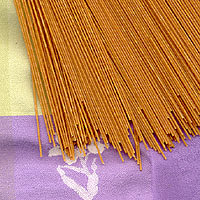Nutrition Notes: Pasta That's Good For You
By Staff in Food on Nov 13, 2009 7:20PM
You’ve likely seen products like “spelt spaghetti” or “quinoa spirals” while perusing the pasta section of your grocery store. These alternatives to refined white pasta typically provide more nutrients and fiber and impart unique tastes and textures. When consumed in moderation, pasta has its place in a nutritious diet. A healthy serving of pasta is generally about ½ cup cooked, or about ¼ of your plate, which is a whole lot less than what we typically consume. Think of pasta as a great side dish to accompany lean meat or fish and a big helping of veggies. Here is a quick run-down of some commonly sold alternative grain pastas.
Spelt Pasta: An ancient grain that is high in B-vitamins, in particular niacin, which is believed to provide protection against cardiovascular disease by lowering cholesterol. The unique combination of nutrients in spelt is thought to relieve migraine headaches. Spelt pasta is a tad sweeter than regular whole wheat, and is sold in a regular and “white” version, the latter of which has as lighter, more refined, texture.
Kamut Pasta: This pasta is made with whole grain wheat that is higher in protein and minerals, vitamins and unsaturated fatty acids than regular wheat. Kamut is enjoyed for its nutty taste and smooth texture.
Quinoa Pasta:The mother of all grains, according to the Incas. Quinoa is an extremely nutritious grain originating from the Andes region of South America. Quinoa contains the most protein of all the grains, and is also high in calcium and iron.
Buckwheat Pasta: Despite the name, buckwheat is not related to wheat. It’s a fruit seed related to rhubarb and sorrel. Buckwheat contains potent flavonoids that researchers believe strengthen capillary walls, reduce cholesterol, prevent cancer and have anti-allergy benefits.
Whole Wheat Pasta: This variety incorporates the whole grain kernel, including the bran, germ and endosperm, thus provides substantially more fiber and nutrients than its “white” counterpart. Whole wheat pasta typically has a nutty taste and chewy texture. If your first sampling of whole wheat pasta turned you off, shop around as taste varies among different brands.
— Megan Tempest
